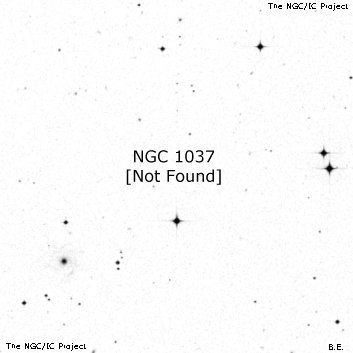NGC/IC Project Restoration Effort
(This is a very very beta version)
NGC1037


Basic Information
Location and Magnitude
Right Ascension: 2:39:58.3
Declination: -1:44:3
Constellation: CET
Visual Magnitude:
Historic Information
Discoverer: Swift L.
Year of discovery: 1886
Discovery aperture: 16.0
Observational
Summary description: eeF, vS, mE, v diffic
Sub-type: NF
Corwin's Notes
=====
NGC 1037. Swift found this on the night of 29 Sept 1886, and gives an 1885.0
position of 02 34 08 -02 13 47, describing it as "eeeF; vS; vE; eee diff;
[GC] 581 [NGC 1032] in field" in his 5th list of new nebulae. Something is
obviously wrong since NGC 1032 is at 02 33 29 +00 35.9 (1885) and probably has
no other galaxies bright enough for Swift to have seen within 16 arcmin of it
(he used an eyepiece that gave a field of 33 arcmin, so if N1032 is "in
field," it must have been within 16.5 arcmin, assuming that N1037 was
centered). In addition, Swift's quoted declination is 2 deg 49.7 min south of
NGC 1032. I don't see any obvious typos, so I've had to conclude "not found"
for N1037.
-----
After I wrote the preceding paragraph, I learned that Wolfgang Steinicke (and
the catalogues that I noted in the position table note) have suggested that
NGC 1037 is actually UGC 2119 = A0235-02, two minutes of time preceding
Swift's position, and 6.7 arcmin south. This is certainly possible as there
are several other larger RA errors in Swift's 5th list. However, this still
leaves the problem of NGC 1032 being nearly 3 degrees to the north.
Looking at the field, two other possibilities suggest themselves. First,
Swift may have picked up UGC 2106 which is in the same field as UGC 2119.
This would suggest that he somehow thought that U2119 was NGC 1032.
Secondly, if he had NGC 1032 correctly identified, then it is just barely
possible that he might have also seen the very faint galaxy about 4 arcmin
northwest. This is quite flattened, and might be visible in a 16-inch under
very good skies. However, there are brighter stars near it -- in particular,
a star is less than an arcminute to the northeast. Why didn't Swift mention
any of these? This hypothesis also requires a large error in position (50
seconds in RA and 2 deg 53 min in Dec).
Finally, Courtney Seligman has suggested another solution: Swift's object is
actually IC 243 with a -1m 30s, +5deg 10arcmin error in the position. Here,
the other galaxy in the field would be NGC 1022, just 13.5 arcmin to the
north. This has the advantage of picking up a bright/faint galaxy pair that
Swift could have seen, but the disadvantage of requiring large errors in both
his RA and his Dec. See Courtney's web page and note on this object for his
thoughts.
All in all, none of these hypotheses strike me as entirely plausible, but have
included them all in the position table for your consideration.



